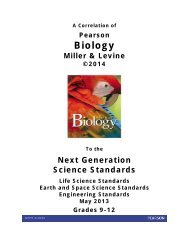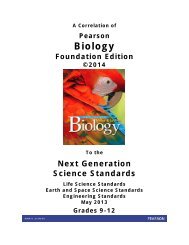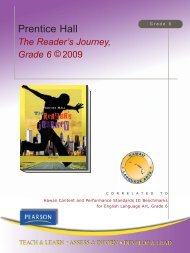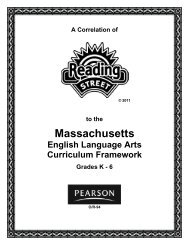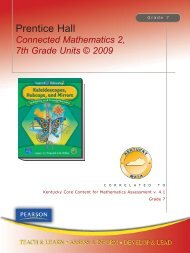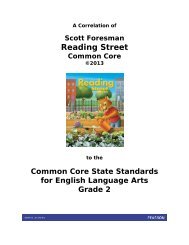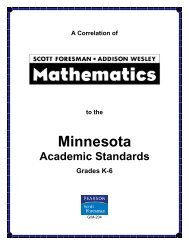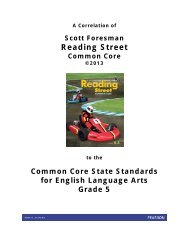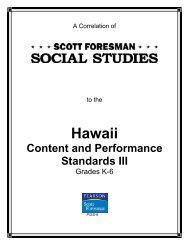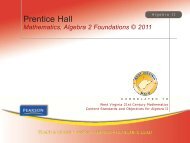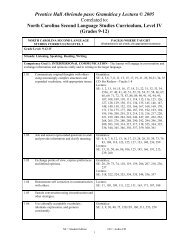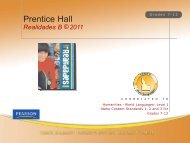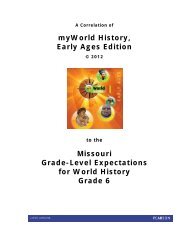Scott Foresman Social Studies, c. 2011, Grades 4-6, to the ... - Pearson
Scott Foresman Social Studies, c. 2011, Grades 4-6, to the ... - Pearson
Scott Foresman Social Studies, c. 2011, Grades 4-6, to the ... - Pearson
Create successful ePaper yourself
Turn your PDF publications into a flip-book with our unique Google optimized e-Paper software.
A Correlation of© <strong>2011</strong><strong>to</strong> <strong>the</strong>TerraNova Content Descriptions<strong>Grades</strong> 4 - 6D/SS-8
INTRODUCTIONThis document demonstrates how well <strong>Scott</strong> <strong>Foresman</strong> <strong>Social</strong> <strong>Studies</strong> © <strong>2011</strong> meets <strong>the</strong> TerraNova Content Descriptions for<strong>Grades</strong> 4-6. Correlation page references are <strong>to</strong> <strong>the</strong> Teacher’s Edition. Lessons in <strong>the</strong> Teacher’s Edition contain facsimile pages of <strong>the</strong>Student Edition.<strong>Scott</strong> <strong>Foresman</strong> is pleased <strong>to</strong> introduce our <strong>Scott</strong> <strong>Foresman</strong> <strong>Social</strong> <strong>Studies</strong>, <strong>the</strong> social studies program that helps everychild become an active, involved, and informed citizen.Content<strong>Scott</strong> <strong>Foresman</strong> <strong>Social</strong> <strong>Studies</strong> content covers <strong>the</strong> key social studies strands: Citizenship, Culture, Economics, Geography,Government, His<strong>to</strong>ry and Science/Technology. <strong>Scott</strong> <strong>Foresman</strong> <strong>Social</strong> <strong>Studies</strong> content is organized for a flexible teachingplan. If time is short, teachers may use <strong>the</strong> Quick Teaching Plan <strong>to</strong> cover <strong>the</strong> core content and skills or <strong>to</strong> add depth, teachersmay use <strong>the</strong> wealth of information in each unit.Accessibility<strong>Scott</strong> <strong>Foresman</strong> <strong>Social</strong> <strong>Studies</strong> provides systematic instruction <strong>to</strong> improve comprehension and <strong>to</strong> reach out <strong>to</strong> all learners.In every unit, reading skills are developed through built-in lessons. Target comprehension skills are pre-taught and <strong>the</strong>n appliedthroughout <strong>the</strong> unit for sustained practice. Graphic organizers provide support for every skill.Motivation<strong>Scott</strong> <strong>Foresman</strong> <strong>Social</strong> <strong>Studies</strong> is filled with compelling visuals, intriguing facts, and exciting real-world learning. ColonialWilliamsburg Lessons provide exciting, special features from <strong>the</strong> nation’s largest living museum. Dorling Kindersley VisualLessons provide bold, large-as life pho<strong>to</strong>graphs with interesting, easy-<strong>to</strong>-read exposi<strong>to</strong>ry captions. Music lessons introduce orreinforce important concepts and vocabulary. Discovery Channel School projects provide exclusive, hands-on unit projects thatsyn<strong>the</strong>size and enhance learning. A special feature entitled You Are There provides captivating suspense-packed reading thatbuilds excitement and lets students experience <strong>the</strong> event from a personal perspective. A Web-Based Information Centercontinually updates information, maps, and biographies.Accountability<strong>Scott</strong> <strong>Foresman</strong> <strong>Social</strong> <strong>Studies</strong> provides built-in skill lessons in every unit and multiple assessment <strong>to</strong>ols <strong>to</strong> develop thinkingcitizens. Informal assessment opportunities moni<strong>to</strong>r children’s learning and provide If/<strong>the</strong>n guidelines with specific reteachingstrategies and effective practice. Formal assessment opportunities assess children’s learning and provide practice for key testtakingskills. Test-taking strategy lessons provide test preparation for national and state tests.
Table of ContentsGrade 4 - Regions __________________________________________________________ 1Grade 5 - Building a Nation___________________________________________________ 5Grade 6 - The World ________________________________________________________ 9
<strong>Scott</strong> <strong>Foresman</strong> <strong>Social</strong> <strong>Studies</strong> (Regions) © <strong>2011</strong><strong>to</strong> <strong>the</strong>TerraNova Content DescriptionsGrade 4Objective: Subskills26 GeographicPerspectivesThe world in spatial termsPlaces and regionsHuman systemsEnvironment and societyTestLevels11-21/22Objective StatementDemonstrate an understanding ofconcepts and process skills related<strong>to</strong> <strong>the</strong> study of <strong>the</strong> world’s people,places, and environments, and <strong>the</strong>irinteractions over time.<strong>Scott</strong> <strong>Foresman</strong><strong>Social</strong> <strong>Studies</strong>SE/TE: Human EnvironmentalInteraction, 110–111, 115, 118, 142–146, 211–213, 234–235, 236–237,238–239, 250–251, 270, 271, 272,281, 282, 314–317, 347, 348, 384–387; Map Handbook, H10–H22;Maps, 11, 19, 20, 22, 25, 40, 41,105, 114, 133, 167, 173, 181, 191,195, 234, 247, 265, 281, 309, 326,333, 347, 372, 381, 387, 401, 403,409, 414, R2-R15; Map and GlobeSkills, 24, 54, 86, 170, 408; MapAdventure, 83, 144, 174, 279, 341,402; Regions and Landforms, 10–17;Climate, 18–23; Regional Resources,26–31; The Beautiful Nor<strong>the</strong>ast, 104–106; Coastal Plains <strong>to</strong> <strong>the</strong> Mountains,166–169; A Route <strong>to</strong> <strong>the</strong> Sea, 232–237; Land of Canyons, 300–304; ALand of Mountains, 368–373Construct answers, use geographic<strong>to</strong>ols, and create solutions usinginquiry skills and knowledge related<strong>to</strong> geographic perspectives.SE/TE: Geography, H11, 9, 15, 24,37, 40, 65, 69, 103, 125, 165, 170,173, 187, 196, 211, 231, 255, 283,299, 323, 367, 393, 409, 412; Link <strong>to</strong>Geography, 138, 3731 Grade 4
Objective: Subskills27 His<strong>to</strong>rical andCultural PerspectivesCultures, culturaldiversityPeople, places, eventsTime, continuity, changeHis<strong>to</strong>rical researchTestLevels11-21-22Objective StatementDemonstrate an understanding ofconcepts and process skills related<strong>to</strong> <strong>the</strong> study of time, continuity, andsocietal change throughout his<strong>to</strong>ry.<strong>Scott</strong> <strong>Foresman</strong><strong>Social</strong> <strong>Studies</strong>SE/TE: Important Events, 38–44,126–129, 130–133, 134–135, 136–138, 140–141, 142–146, 188–192,194–199, 202–206, 210–213, 256–259, 264–266, 276–282, 324–328,332–337, 338–343, 344–345, 346–348, 394–397, 400–406, 410–415;Biography, 45, 53, 139, 147, 193,207, 267, 273, 283, 305, 329, 349,389, 407Demonstrate an understanding ofconcepts and process skills related<strong>to</strong> <strong>the</strong> study of <strong>the</strong> contributions,influences, and interactions ofvarious cultures.SE/TE: Culture, 1f, 4, 13, 17, 41, 45,53, 74–75, 95f, 98, 107–108, 115,139, 147, 152–153, 157f, 160, 179–180, 183, 193, 207, 267, 271–272,273, 283, 294, 305, 310–311, 312,329, 345, 349, 354–355, 359f, 362,373, 385–386, 389, 399, 407Construct answers and createsolutions using inquiry skills andknowledge related <strong>to</strong> his<strong>to</strong>rical andcultural perspectives.SE/TE: His<strong>to</strong>ry, H8, 51, 70, 127,143, 168, 179, 190, 204, 205, 268,319, 326, 331, 335, 411; Culture, 43,82, 205, 215, 257, 269, 302, 336,342, 345, 39828 Civics andGovernment PerspectivesPurposes of governmentDemocratic values andprinciplesGovernment processesand structures11-21/22Demonstrate an understanding ofconcepts and process skills related<strong>to</strong> <strong>the</strong> study of civic responsibilitiesand <strong>to</strong> <strong>the</strong> structures, functions, andpurposes of government.SE/TE: We <strong>the</strong> People, 46–52; TheStrengths of Our Freedoms, 56–59;Taking a Stand, 136-138; DorlingKindersley: Winning <strong>the</strong> Right <strong>to</strong>Vote, 140–141; Civil RightsMovement, 206; Citizen Heroes, 60,148, 200, 260, 318, 416; Biography,2 Grade 4
Objective: SubskillsThe role of <strong>the</strong> citizenWorld affairsTestLevelsObjective StatementContinued<strong>Scott</strong> <strong>Foresman</strong><strong>Social</strong> <strong>Studies</strong>139, 207; Issues and Viewpoints,238–239, 350–351Construct answers and createsolutions using inquiry skills andknowledge related <strong>to</strong> <strong>the</strong> role of<strong>to</strong>day’s citizens and <strong>the</strong> structuresand functions of government.SE/TE: Citizenship Activities, 38–41,42–44, 46–48, 49–52, 56–59, 60–61,62–63, 123, 136–138, 139, 148–149,200–201, 205, 238–239, 260–261,318–319, 350–351, 416–417;Government, 43, 51, 189, 282;Citizenship, H2, 45, 61, 128, 141,148, 200, 207, 260, 274, 275, 318,354, 416; Issues and Viewpoints,238–239, 350–35129 EconomicPerspectivesProduction, distribution,consumptionEconomic institutionsand systemsGlobal connections,interdependence11-21/22Demonstrate an understanding ofconcepts and process skills related<strong>to</strong> <strong>the</strong> study of <strong>the</strong> production,distribution, and consumption ofgoods and services at local, regional,and global levels.Demonstrate an understanding ofconcepts and process skills related<strong>to</strong> <strong>the</strong> study of economic institutionsand systems.SE/TE: The Land of Plenty, 66-71;Trade Then and Now, 72-79;Transportation and Communication,80-86; Cities and Industry, 145;Trade, 277, 278, 280, 414;Interdependent, 81-82; Workers,143, 146, 147, 260, 261SE/TE: Economic Decisions, 29, 60-61, 74, 78-79, 88-89, 318-319, 350-351; Economic Issues, 66–71, 72–79,112–115, 116–119, 178, 246–247,248–249, 314–319, 338–340, 384–3883 Grade 4
Objective: SubskillsContinuedTestLevelsObjective StatementConstruct answers and createsolutions using inquiry skills andknowledge related <strong>to</strong> economicperspectives.<strong>Scott</strong> <strong>Foresman</strong><strong>Social</strong> <strong>Studies</strong>SE/TE: Economic Decisions, 29, 60-61, 74, 78-79, 88-89, 318-319, 350-351; TE only: Economics, 27, 73,182, 250, 315, 387, 403, 4144 Grade 4
<strong>Scott</strong> <strong>Foresman</strong> <strong>Social</strong> <strong>Studies</strong> (Building a Nation) © <strong>2011</strong><strong>to</strong> <strong>the</strong>TerraNova Content DescriptionsGrade 5Objective: Subskills26 GeographicPerspectivesThe world in spatial termsPlaces and regionsHuman systemsEnvironment and societyTestLevels11-21/22Objective StatementDemonstrate an understanding ofconcepts and process skills related<strong>to</strong> <strong>the</strong> study of <strong>the</strong> world’s people,places, and environments, and <strong>the</strong>irinteractions over time.<strong>Scott</strong> <strong>Foresman</strong><strong>Social</strong> <strong>Studies</strong>SE/TE: Land and Regions, 24–30;Map Handbook, H12–H22; Maps, 24,26, 29, 32, 33, 34, 53, 54, 55, 60,62, 63, 66, 68, 75, 76, 77, 82, 84,88, 89, 94, 95, 101, 102, 103, 106,107, 110, 111, 114, 133, 134, 137,140, 141, 142, 146, 147, 148, 153,155, 156, 159, 164, 166, 168, 171,176, 177, 201, 202, 205, 206, 210,216, 224, 226, 231, 232, 234, 235,240, 242, 244, 245, 246, 248, 250,267, 268, 271, 276, 278, 286, 288,290, 295, 296, 302, 305, 314, 317,337, 338, 341, 342, 344, 352, 361,362, 365, 370, 375, 378, 379, 380,387, 401, 402, 403, 405, 408, 412,416, 429, 430, 431, 435, 438, 440,442, 463, 464, 470, 473, 476, 477,479, 484, 486, 491, 492, 498, 500,506, 507, 509, 513, 516, 523, R4,R6, R7, R8, R9, R10, R12, R14; Mapand Globe Skills, 32, 140, 244, 378,512; Map Adventure, 114, 159, 248,278, 365, 412, 507; Mental Mapping,27, 53, 75, 101, 133, 155, 201, 231,267, 317, 337, 361, 401, 429, 4915 Grade 5
Objective: SubskillsContinuedTestLevelsObjective StatementConstruct answers, use geographic<strong>to</strong>ols, and create solutions usinginquiry skills and knowledge related<strong>to</strong> geographic perspectives.<strong>Scott</strong> <strong>Foresman</strong><strong>Social</strong> <strong>Studies</strong>SE/TE: Geography, 27, 29, 32, 113,115, 140, 165, 181, 213, 245, 372,378, 379, 477, 479, 513; Link <strong>to</strong>Geography, 30, 91, 109, 150, 162,182, 14, 251, 291, 366, 43627 His<strong>to</strong>rical andCultural PerspectivesCultures, culturaldiversityPeople, places, eventsTime, continuity, changeHis<strong>to</strong>rical research11-21-22Demonstrate an understanding ofconcepts and process skills related<strong>to</strong> <strong>the</strong> study of time, continuity, andsocietal change throughout his<strong>to</strong>ry.SE/TE: Interpret Time Lines, 47, 49,127, 129, 197, 263, 331, 333, 397,457, 459; Chapter Reviews, 72–73,98–99, 118–119, 152–153, 186–187,228–229, 252–253, 292–293, 322–323, 358–359, 386–387, 426–427,448–449, 488–489, 522–523; Thenand Now, 10, 111, 144, 211, 277,383, 433, 472Demonstrate an understanding ofconcepts and process skills related<strong>to</strong> <strong>the</strong> study of <strong>the</strong> contributions,influences, and interactions ofvarious cultures.SE/TE: Culture, 9, 26, 63, 65, 67,68, 71, 85, 90, 107, 136, 166, 173,185, 218, 241, 289, 313, 381, 404,451, 518; Life in <strong>the</strong> WesternHemisphere, 52–73; NativeAmericans of North America, 74–99;Life in <strong>the</strong> Eastern Hemisphere, 100–119; Spain Builds an Empire, 132–153; The Struggle <strong>to</strong> Found Colonies,154–187; Life in <strong>the</strong> English Colonies,200–229; The Fight for a Continent,230–253; The Road <strong>to</strong> War, 266–293; Winning <strong>the</strong> Revolution, 294–323; The Young United States, 360–387; Times of Change, 400–427;People Moving South and West, 428–449; A Divided Nation, 462–489; Warand Reconstruction, 490–5236 Grade 5
Objective: SubskillsContinuedTestLevelsObjective StatementConstruct answers and createsolutions using inquiry skills andknowledge related <strong>to</strong> his<strong>to</strong>rical andcultural perspectives.<strong>Scott</strong> <strong>Foresman</strong><strong>Social</strong> <strong>Studies</strong>SE/TE: Culture, 9, 26, 63, 65, 67,68, 71, 85, 90, 107, 136, 166, 173,185, 218, 241, 289, 313, 381, 404,451, 518; His<strong>to</strong>ry, 346, 375, 382,424, 440, 443, 48128 Civics andGovernment PerspectivesPurposes of governmentDemocratic values andprinciplesGovernment processesand structuresThe role of <strong>the</strong> citizenWorld affairs11-21/22Demonstrate an understanding ofconcepts and process skills related<strong>to</strong> <strong>the</strong> study of civic responsibilitiesand <strong>to</strong> <strong>the</strong> structures, functions, andpurposes of government.SE/TE: Government by <strong>the</strong> People,14–17; Debate in Philadelphia, 344–350; Ratifying <strong>the</strong> Constitution, 352–355; Review, 358–359; ThirteenthAmendment, 517; New Amendments,519; Text of <strong>the</strong> United StatesConstitution, R30–R52; Issues andViewpoints, 222–223, 310–311, 368–369; Citizen Heroes, 40, 92, 184,274, 422, 504; also see: MakeDecisions, 17, 22, 85, 162, 169, 182,207, 271, 282, 304, 363, 382, 384,444; Solve Problems, 87, 111, 144,145, 159, 203, 251, 255, 278, 341,412, 413, 471, 494, 503, 505, 518Construct answers and createsolutions using inquiry skills andknowledge related <strong>to</strong> <strong>the</strong> role of<strong>to</strong>day’s citizens and <strong>the</strong> structuresand functions of government.SE/TE: Citizenship, H2, 41, 92, 160,184, 275, 277, 300, 306, 363, 369,423, 472, 499, 508; Government, 9,41, 68, 170, 222, 234, 348, 349,477, 520; Issues and Viewpoints,222–223, 310–311, 368–369; CitizenHeroes, 40, 92, 184, 274, 422, 5047 Grade 5
Objective: Subskills29 EconomicPerspectivesProduction, distribution,consumptionEconomic institutionsand systemsGlobal connections,interdependenceTestLevels11-21/22Objective StatementDemonstrate an understanding ofconcepts and process skills related<strong>to</strong> <strong>the</strong> study of <strong>the</strong> production,distribution, and consumption ofgoods and services at local, regional,and global levels.Demonstrate an understanding ofconcepts and process skills related<strong>to</strong> <strong>the</strong> study of economic institutionsand systems.<strong>Scott</strong> <strong>Foresman</strong><strong>Social</strong> <strong>Studies</strong>SE/TE: Life in <strong>the</strong> EasternHemisphere, 100–119; Life in <strong>the</strong>English Colonies, 200–229; A NewKind of Revolution, 408–411; Northand South Grow Apart, 464–467SE/TE: Free Enterprise, 18–22;Trade, 20, 102–104, 106–108, 112–115, 206–207; A New Kind ofRevolution, 408–411; Unions, 485,493–495Construct answers and createsolutions using inquiry skills andknowledge related <strong>to</strong> economicperspectives.SE/TE: Economics, 21, 22, 30, 35,78, 79, 84, 103, 114, 148, 157, 177,179, 203, 204, 212, 243, 254, 269,279, 321, 339, 410, 444, 465, 5028 Grade 5
<strong>Scott</strong> <strong>Foresman</strong> <strong>Social</strong> <strong>Studies</strong> (The World) © 2008<strong>to</strong> <strong>the</strong>TerraNova Content DescriptionsGrade 6Objective: Subskills26 GeographicPerspectivesThe world in spatial termsPlaces and regionsHuman systemsEnvironment and societyTestLevels11-21/22Objective StatementDemonstrate an understanding ofconcepts and process skills related<strong>to</strong> <strong>the</strong> study of <strong>the</strong> world’s people,places, and environments, and <strong>the</strong>irinteractions over time.<strong>Scott</strong> <strong>Foresman</strong><strong>Social</strong> <strong>Studies</strong>SE/TE: The Fertile Crescent, 34–39;The Lifeline of <strong>the</strong> Nile, 78–81; TheGeography of China, 100–103; TheGeography of South Asia, 122–125;Geography of Mesopotamia, 162–165; Geography of South America,186–189; Geography of NorthAmerica, 208–211; The Geography ofGreece, 246–249; Rome’sBeginnings, 276–279; Migration, 12,14-16, 130, 251, 347, 372, 615, 656;Interacting with <strong>the</strong> Environment,10–17, 18–25, 322–325, 370–373,392–395, 660–663, 664–667Construct answers, use geographic SE/TE: Geography, H12, H16, 82,<strong>to</strong>ols, and create solutions using 102, 123, 166, 188, 194, 247, 259,inquiry skills and knowledge related 301, 397, 412, 460, 463, 465, 523,659; Map Adventure, 38, 94, 200,<strong>to</strong> geographic perspectives.261, 337, 440, 577, 662; Maps andMap Skills, H10-H24, 15, 21, 35, 49,57, 58, 79, 93, 101, 109, 110, 124,130, 132, 138, 142, 163, 170, 175187, 198, 210, 214, 220, 247, 263,267, 277, 286, 290, 296, 300, 303,323, 327, 332, 347, 348, 352, 357,362, 371, 373, 377, 383, 393, 397,407, 409, 410, 431, 436, 441, 446,448, 457, 460, 469, 488, 494, 499,501, 502, 522, 529, 531, 535, 546,9 Grade 6
Objective: SubskillsTestLevelsObjective Statement<strong>Scott</strong> <strong>Foresman</strong><strong>Social</strong> <strong>Studies</strong>Continued 549, 552, 553, 569, 574, 583, 586,608, 610, 616, 617, 622, 632, 637,638, 639, 645; Atlas, R2-R1927 His<strong>to</strong>rical andCultural PerspectivesCultures, culturaldiversityPeople, places, eventsTime, continuity, changeHis<strong>to</strong>rical research11-21-22Demonstrate an understanding ofconcepts and process skills related<strong>to</strong> <strong>the</strong> study of time, continuity, andsocietal change throughout his<strong>to</strong>ry.SE/TE: Time Lines, 2–3, 4–5, 70–71,72–73, 154–155, 156–157, 238–239,240–241, 314–315, 316–317, 422–423, 424–425, 512–513, 514–1515,598–599, 600–601; Parallel TimeLines, 524–525, R29–R40; ChapterReviews, 30–31, 62–63, 96–97, 118–119, 146–147, 182–183, 204–205,230–231, 272–273, 306–307, 342–343, 366–367, 388–389, 414–415,452–453, 482–483, 504–505, 538–539, 564–565, 590–591, 626–627,672–673Demonstrate an understanding ofconcepts and process skills related<strong>to</strong> <strong>the</strong> study of <strong>the</strong> contributions,influences, and interactions ofvarious cultures.SE/TE: Culture, 52, 55, 81, 129,165, 249, 262, 269, 329, 331, 376,399, 401, 404, 409, 416, 465, 557,579, 585, 656; Early Civilizations, 32-63; Ancient Egypt and Nubia, 76-97;Ancient China, 98-119; Ancient Indiaand Persia, 120-147; MesoamericanCivilizations, 160-183; The EarlyPeoples of South America, 184-205;Early North American Peoples, 206-231; Ancient Greece, 244-273;Ancient Rome, 274-311; ByzantineEmpire and Ancient Arabia, 320-343;Asian Empire, 344-367; AfricanEmpire, 368-389; Medieval Europe,390-419; New Beginnings, 428–453;Ideas and Movements, 454–483;10 Grade 6
Objective: SubskillsTestLevelsObjective StatementContinued<strong>Scott</strong> <strong>Foresman</strong><strong>Social</strong> <strong>Studies</strong>Imperialism, Nationalism, andUnification, 484–507; The World atWar, 518–539; From Peace <strong>to</strong> War,540–565; The Cold War, 566–591;New Nations, 604–627; Cooperation,Conflict, and Challenges, 628–651Construct answers and createsolutions using inquiry skills andknowledge related <strong>to</strong> his<strong>to</strong>rical andcultural perspectives.SE/TE: His<strong>to</strong>ry, 15, 79, 115, 137,269, 302, 329, 331, 332, 335, 441,458, 464, 487, 550, 556, 570, 571,611, 613, 615, 638; Culture, 52, 55,81, 129, 165, 249, 262, 269, 329,331, 376, 399, 401, 404, 409, 416,465, 557, 579, 585, 65628 Civics andGovernment PerspectivesPurposes of governmentDemocratic values andprinciplesGovernment processesand structuresThe role of <strong>the</strong> citizenWorld affairs11-21/22Demonstrate an understanding ofconcepts and process skills related<strong>to</strong> <strong>the</strong> study of civic responsibilitiesand <strong>to</strong> <strong>the</strong> structures, functions, andpurposes of government.SE/TE: Monarchy, 47, 51, 399, 402,467; Feudalism, 401–402; Theocracy,169; Communism, 531, 578; City-States, 252–257; Empire, 266–269,288–293, 346–349, 350–355;Democracy, 245, 255, 257, 283, 284,398, 447, 457-458, 459, 460, 462,466-469, 471, 472-473, 588-589,606-612, 621-623; Dicta<strong>to</strong>r, 283,541, 544, 546; Issues andViewpoints, 228–229, 588–589;Citizen Heroes, 17-18, 88-89, 202-203, 293-294, 339-340, 471-472,573-574, 643-644Construct answers and createsolutions using inquiry skills andknowledge related <strong>to</strong> <strong>the</strong> role of<strong>to</strong>day’s citizens and <strong>the</strong> structuresand functions of government.SE/TE: Government, 133, 284, 255,290, 502; Citizenship, H2, 17, 88,199, 305, 327, 351, 573, 609, 640,647; Citizen Heroes, 17-18, 88-89,202-203, 293-294, 339-340, 471-472, 573-574, 643-64411 Grade 6
Objective: Subskills29 EconomicPerspectivesProduction, distribution,consumptionEconomic institutionsand systemsGlobal connections,interdependenceTestLevels11-21/22Objective StatementDemonstrate an understanding ofconcepts and process skills related<strong>to</strong> <strong>the</strong> study of <strong>the</strong> production,distribution, and consumption ofgoods and services at local, regional,and global levels.Demonstrate an understanding ofconcepts and process skills related<strong>to</strong> <strong>the</strong> study of economic institutionsand systems.<strong>Scott</strong> <strong>Foresman</strong><strong>Social</strong> <strong>Studies</strong>SE/TE: Economic Concepts, 38, 59,89, 169, 269, 282–287, 336, 348,351, 371, 374, 375, 376–378, 394,399, 403, 411, 474–477, 478–481,494, 543, 537, 544, 611, 621, 628–629, 630–633SE/TE: Feudalism, 401–402; TheIndustrial Revolution, 474–477; TheSecond Industrial Revolution, 478–481; Imperialism, 492–496;Depression, 542–547; Changes inEastern Europe, 621; EconomicCooperation, 630–633; Earth’sEnvironment, 660–663; Energy, 664-667; Technology: Computers, 668-669; Trade, 38, 39, 58, 59, 89, 94,99, 110, 112, 169, 220, 248, 324,335, 336, 338, 362, 363, 369, 375,378, 381, 385, 391, 408, 411, 431,439, 445, 449, 631, 632, 633Construct answers and createsolutions using inquiry skills andknowledge related <strong>to</strong> economicperspectives.SE/TE: Economics, 38, 59, 169, 220,269, 336, 348, 351, 371, 375, 394,399, 403, 411, 494, 543, 557, 611,63212 Grade 6



